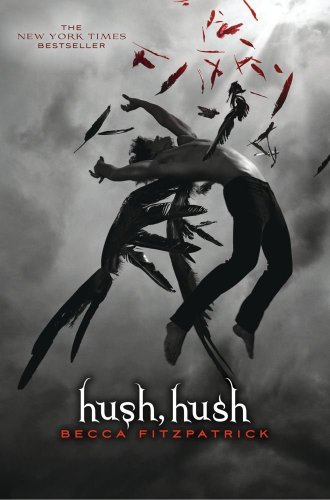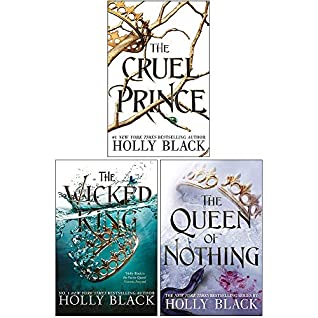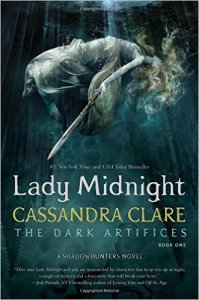 I haven’t done a book review on here for a while, and I have quite a few to get caught up on. I read the first two books in Becca Fitzpatrick’s Hush, Hush series back in May, and finally got around to reading the third and fourth book this August. I decided to just review all of them briefly in one post. Overall, I really enjoyed them, although unfortunately the last installment didn’t quite pull me in like the others did.
I haven’t done a book review on here for a while, and I have quite a few to get caught up on. I read the first two books in Becca Fitzpatrick’s Hush, Hush series back in May, and finally got around to reading the third and fourth book this August. I decided to just review all of them briefly in one post. Overall, I really enjoyed them, although unfortunately the last installment didn’t quite pull me in like the others did.
I actually became curious about the series because of a few bad reviews I saw about it. Well, “bad” is probably putting it lightly…”scathing” is more like it. And they had less to do with Ms. Fitzpatrick’s writing style/plot/characters and more to do with her main male character, Patch, her quintessential reformed (or is he?) bad boy character, because, you know, it’s impossible to enjoy a character in a book/TV show/movie while recognizing their less desirable qualities wouldn’t make for a good partner in real life. (That’s sarcasm, by the way.) And, although they’re in the minority, she’s also gotten some bad reviews on Goodreads…and this time, by “bad,” I mean actually just pretty horrible and inappropriate. Basically just bullying. I mean, it’s the Internet, so they could be trolls…but if they’re not, there’s really no good excuse for bullying anyone, ever, no matter how justified you think your cause is. (I know by now you’re probably wondering what the heck I’m talking about, so go on Goodreads and take a look for yourself.)
A little more about this at the end of the post. For now, let’s take a quick look at each of the books:
1. Hush, Hush
I thought this was a great debut novel, and I thoroughly enjoyed Ms. Fitzpatrick’s writing style. She sets the story in the slightly dreary Coldwater, Maine, and creates this perfectly sinister, creepy, Halloween-ish atmosphere. It was reminiscent of L.J. Smith’s earlier work (although, in my mind, few people–if anyone–can trump L.J.). Yes, at this point the plot-line is somewhat overdone and predictable, but I gobbled it up just the same: Nora Grey, a smart, cute-if-something-of-a-misfit high school student, encounters Patch, dark, mysterious boy who seems like bad news, and yet Nora can’t resist his magnetic pull (obviously). I know I sound snarky, but I honestly devoured it. The book is mostly centered around unraveling the mystery that is Patch and his relationship with Nora.
Some have criticized the book as being a Twilight ripoff. There are some parallels, but nothing that jumped out at me as obvious plagiarism. I mean, to give credit where credit’s due, Twilight did open up the market for teen paranormal romance, so there are going to be some similarities. But it is also quite possible for two or more people to come up with fairly similar ideas without being influenced directly by each other’s work.
The books are told from Nora’s point-of-view, and I really liked her character. She’s a smart, motivated high school student. Her best friend, Vee, adds some comic relief to the series and is my favorite character. Nora is also the victim of some pretty vicious pranks by Coldwater’s resident mean rich girl, Marcie Millar. I enjoyed most of the characters, even though secondary ones like Vee and Marcie never seem to break out of their stereotypes. (Marcie starts to, a little, later in the series.)
In fact, I have to say the only character I found to be a little underwhelming was…Patch. For being the dark, mysterious, sexy bad boy, he didn’t really pop off the page for me as much as he should. Also, I never could quite get past his nickname. Patch is just not a sexy nickname, in my opinion. It makes me think of an old pirate with missing teeth or a little kid who gets into a lot of mischief and ends up hurting himself.
But, overall, an entertaining read. I gave it four/five stars on Goodreads because it built up a lot to a twist at the end that wasn’t that earth-shattering. (There is, however, a perfectly creepy seen at Delphic amusement park and a particular ride called the Archangel…I LOVE creepy amusement parks in horror/paranormal books!!!)
If you haven’t read Hush, Hush yet and plan to, I’d stop reading now…spoilers ahead…
2. Crescendo
In Crescendo, we delve a little further into Ms. Fitzpatrick’s dark world of sexy fallen angels and the cursed Nephilim–the children of fallen angels and humans, languishing in between these two worlds and destined to swear fealty to fallen angels. We know that Patch was a fallen angel in Hush, Hush, but, due to the events at the end, now has his wings back and is a guardian angel. But his relationship with Nora isn’t picture perfect, and she catches him doing some pretty suspicious things…like hanging around her arch-nemesis Marcie an awful lot. It doesn’t help that Vee is dating Rixon, Patch’s bff, so Nora can’t quite avoid Patch/people-that-know-Patch completely. Meanwhile, her mother forces her to reconnect with a childhood friend, Scott, who turns out to have some dark secrets of his own. Rixon, though, was my favorite character in this book until…..oh, Rixon…..
From what I recall, this book ended with a cliffhanger, so be prepared for that.
Four/Five Stars
3. Silence
I enjoyed Silence a lot more than I expected I would considering what happens in the first few pages. Which, thankfully, I can tell you about, since it’s in the book’s synopsis and not a spoiler! Nora can’t remember the past five months of her life…including, of course, Patch. So, yes, part of the book ends up being a series of revelations that the reader already knows. This could have ended up super annoying, but I think Fitzpatrick did an excellent job with it…at least for me, I could see where it might bug some readers. I also enjoyed Patch’s character a lot more in this book, and there were some pretty sexy scenes.
I also gave this book four/five stars, and I did have a few issues with it. First off, what happens to Vee in this book, and especially in the last book? Isn’t she Nora’s bff? Where did she go? It’s like she just disappears for large chunks of books three and four. Since I liked her so much, this was really upsetting. Also, Fitzpatrick seems like she’s setting up a whole Scott-Nora-Patch love triangle…not that I necessarily wanted that to happen, because that’s overdone, too, but it definitely seemed headed in that direction, and then it just…doesn’t. (And then you find out in book four that Scott thinks of Nora like a sister? Um, his affection for her in Silence definitely does not seem brotherly.) There’s also a lot of to-do about Nora and Scott going “as friends” to her homecoming dance–Marcie drags Nora out shopping for a dress, and they make a really big deal about finding a dress, and then–the dance doesn’t happen. The book ends before the dance happens. I found this to just be really strange and kind of sloppy. But I’m still giving it four stars for having a nice blend of sinister, romantic, steamy and funny moments. And Scott, who was kind of a jerk in Crescendo, really redeems himself in this book.
4. Finale
I gave this book three out of five stars because I finished it, but honestly, it was a really disappointing end to the series for me. It had its moments, including some surprising twists at the end with both new and old characters. But all in all, my least favorite in the series. I guess I prefer the off-and-on again of fictional relationships because, when Patch and Nora finally end up together, it’s just…annoying, haha. Their romantic dialogue was a little too contrived or something. It doesn’t all come easy for them in this book–they still have some barriers to overcome, including Nora’s attraction to her own dark side. That could have been a really good, gritty plotline (and something I’m exploring with one of my own characters right now), but it fell short for me. I think because Nora feels too guilty about it, haha. Fitzgerald should have pushed her just a teensy bit more.
I will say, though, that Nora turns into a pretty bad ass character. She has to accept a new leadership role in this book and embrace her Nephilim side, so I liked seeing her character develop in these ways.
***
In summary, it’s a series I would recommend to fans of YA horror/paranormal romance (except for maybe Finale).
And now, to wrap up this review, I’m going to put in my two-cents about the scathing reviews I alluded to above. There are some people who think that the popularity of YA paranormal romance is a reflection of our current culture…and not the nice parts. Now, I get that the books/TV shows/movies of a time period can say a lot about a culture, although I also think part of it is just paranormal romance happens to be one of the “hot” trends right now in book publishing. Its popularity will wax and wane just like everything else, until something new replaces it. That doesn’t mean authors will stop writing in the genre, or that readers will stop reading…just that it won’t be quite the sensation it is now.
That being said, there have always been books that have sought to appeal to our darker side…books that mix elements of the horror genre with elements of romance. I really think that the current YA horror/paranormal romance genre is inspired by (not saying they’re on the same level as) the gothic and dark romanticism movements of long ago–writers like Poe, Hawthorne, Shelley, Lord Byron, the Bronte sisters, Stoker. Writers that explored fringe/outcast characters, antiheroes, and darker themes like the origin of sin, temptation, lust, forbidden love etc. Work that sometimes had a romantic twist to it, albeit a dark one. The idea of darkness being attracted to light, of sin to innocence (like Patch to Nora), is nothing new, and the mere exploring of this theme in writing or some other media is not the same thing as endorsement. So you really don’t have to read the series that way. It’s a forbidden love story…it’s dark and twisted. It’s supposed to be.



 Back cover summary: “Cheerleader Isobel Lanley is horrified when she is paired with Varen Nethers for an English project, which is due—so unfair—on the day of the rival game. Cold and aloof, sardonic and sharp-tongued, Varen makes it clear he’d rather not have anything to do with her either. But when Isobel discovers strange writing in his journal, she can’t help but give this enigmatic boy with the piercing eyes another look.
Back cover summary: “Cheerleader Isobel Lanley is horrified when she is paired with Varen Nethers for an English project, which is due—so unfair—on the day of the rival game. Cold and aloof, sardonic and sharp-tongued, Varen makes it clear he’d rather not have anything to do with her either. But when Isobel discovers strange writing in his journal, she can’t help but give this enigmatic boy with the piercing eyes another look. 
 Clockwork Angel is the first book in Cassandra Clare’s The Infernal Devices trilogy. I love Ms. Clare’s The Mortal Instruments series (City of Heavenly Fire is sitting on my bookcase, waiting patiently for me to read it…but it looks sort of daunting…), and it took me awhile to get around to starting The Infernal Devices…but I am oh so glad I did. For me, it was a five-star read. In my opinion, the back cover book summary does not do this book justice. It makes it sound like it’s only about a love triangle–which, for better or for worse, there is a love triangle in this book. That device has sort of exploded along with YA lit in recent years. But anyway, there is so much more going on in this book than that, and I fell in love with all of the characters.
Clockwork Angel is the first book in Cassandra Clare’s The Infernal Devices trilogy. I love Ms. Clare’s The Mortal Instruments series (City of Heavenly Fire is sitting on my bookcase, waiting patiently for me to read it…but it looks sort of daunting…), and it took me awhile to get around to starting The Infernal Devices…but I am oh so glad I did. For me, it was a five-star read. In my opinion, the back cover book summary does not do this book justice. It makes it sound like it’s only about a love triangle–which, for better or for worse, there is a love triangle in this book. That device has sort of exploded along with YA lit in recent years. But anyway, there is so much more going on in this book than that, and I fell in love with all of the characters. I haven’t done a book review on here for a while, and I have quite a few to get caught up on. I read the first two books in Becca Fitzpatrick’s Hush, Hush series back in May, and finally got around to reading the third and fourth book this August. I decided to just review all of them briefly in one post. Overall, I really enjoyed them, although unfortunately the last installment didn’t quite pull me in like the others did.
I haven’t done a book review on here for a while, and I have quite a few to get caught up on. I read the first two books in Becca Fitzpatrick’s Hush, Hush series back in May, and finally got around to reading the third and fourth book this August. I decided to just review all of them briefly in one post. Overall, I really enjoyed them, although unfortunately the last installment didn’t quite pull me in like the others did.

